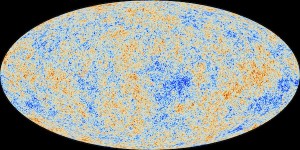main content begins
Cosmology is the study of the Universe as a whole. Cosmologists investigate the origins of the Universe in the Big Bang, 13.8 billion years ago; they study the epochs of inflation and of the formation of the first stars, and the origin and evolution of large-scale structure.
The discovery of the Cosmic Microwave Background (CMB) radiation is a milestone in cosmology. The CMB is the “light left over from the Big Bang” and it provides a snapshot of the cosmos when it was only 380,000 years old, an age prior to the formation of any structure. In March 2013, the Planck space-based observatory provided the most detailed image of the CMB yet, showing the tiny variations in energy density that would lead to future large-scale structure.
Today, cosmologists study the polarization of the CMB to understand the nature of the inflationary epoch, moments after the Big Bang, when the Universe underwent rapid exponential expansion. Gravitational waves from this period would have left their mark on the polarization of the CMB. In this way, observations of the polarization of the CMB from 380,000 years ago are a window on a period mere moments after the Big Bang.
Cosmologists also gain insight into the Universe as a whole by studying its constituent parts. Supernovae are visible at great distances and act as “standard candles” that help refine measurements of the expansion rate of the cosmos. And the radiation from hydrogen gas reveals large-scale structure in its earliest form.
A key realm of cosmological research is dark matter: its nature and its role in the formation and evolution of structure in the Universe. Dark matter is one of the main constituents of the cosmos, making up some 20% of the energy density of the Universe.
But as its name implies, astronomers can’t observe dark matter in the same way they observe stars, nebulae and galaxies. Instead, they infer its existence from the motions of stars within galaxies, and galaxies within clusters of galaxies; the motions of these stars and galaxies reveal a gravitational force greater than could be generated by the visible matter in the galaxy or cluster. This discloses the presence of unseen matter, as does the gravitational lensing caused by clusters.
Dark energy is an even more abundant constituent of the Universe than dark matter, comprising some 70% of the energy density of the Universe. Hubble Space Telescope observations of distant supernovae in the late 1990s revealed that the expansion rate of the Universe was—contrary to expectations—increasing. Dark energy is the force behind the accelerating expansion of the cosmos. It is an enigmatic force that is described as the energy of empty space which increases as space expands, or a mysterious energy field sometimes referred to as “quintessence.”

The Cosmic Microwave Background radiation as imaged by the Planck space telescope. Credit: ESA, Planck
At the Dunlap Institute: